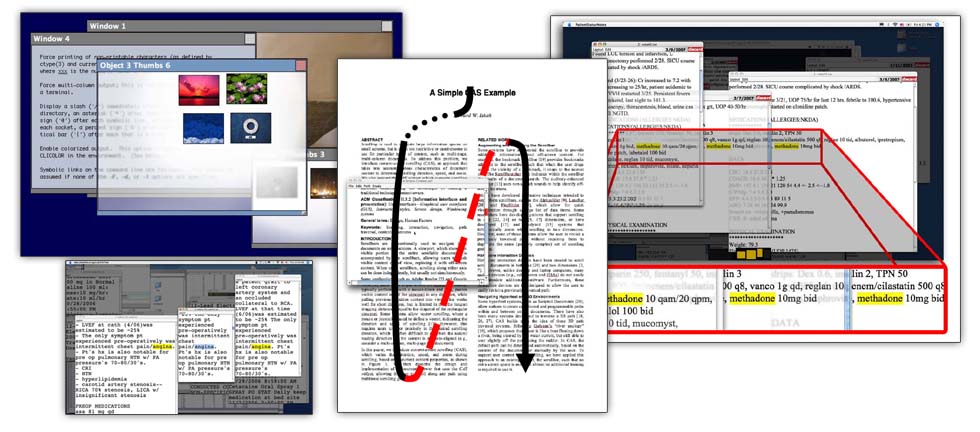Content-Aware Interaction in User Interfaces
PHD CANDIDATE (COLUMBIA UNIVERSITY)
My Ph.D. thesis made the following contributions:
Development and evaluation of content-aware transparency. Content-aware
transparency (CAT), allows a user to interact with otherwise hidden content by
varying the levels of transparency within different regions of a window. In our
implementation, we render important regions opaque and unimportant regions
transparent, with a smooth opaque-to-transparent gradient in between. Based on
properties of the overlapping material, various image-processing filters are
applied to obstructed content to help disambiguate the overlapping material. We
designed, implemented, and evaluated a user interface that employs CAT. Our
user study showed that participants were more effective with the use of CAT and
also preferred user interfaces that employed CAT over ones that did not. We also
developed a set of CAT interaction techniques that allow users to unambiguously
interact with objects rendered with CAT: pop-through, focus filter, and mouseover
pie menu. The pop-through technique allows a user to directly manipulate an
obstructed object. The focus filter technique allows a user to temporarily restore
obstructed image-processed content to its unfiltered form. The mouse-over pie
menu technique allows a user to select an object to interact with from a pie menu
of all objects that are currently under the mouse cursorÕs position.
Development and evaluation of content-aware scrolling. Content-aware scrolling
(CAS) allows a user to scroll along a document path defined by the user or
system, varying the direction, speed, and zoom of scrolling depending on the
documentÕs content and the task at hand. We designed, implemented, and
evaluated a user interface that employs CAS. Our CAS Document Viewer
automatically extracts the reading path and search paths within text PDF
documents, as well as the faces path within photographs containing peopleÕs
faces, and allows one to traverse these paths using traditional scrolling gestures
(e.g., using the mouse scroll wheel). Our user study showed that participants
greatly prefer using CAS to peruse unfamiliar documents. CAS also significantly
outperformed both traditional and vector (i.e., free) scrolling in short distance
navigation tasks.
Development of content-aware layout. Content-aware layout (CAL) takes into
consideration the contents of windows on a userÕs desktop to determine if and
where they should be placed on the screen by applying constraints to content
within the windows, rather than to the windowsÕ bounds. We developed a testbed
application to demonstrate how CAL could be useful when perusing text
documents. When a user selects text within a window, CAL rearranges other
windows containing that text, horizontally aligning the search results of those
windows with the selected text. Similarly, a user can perform a search across all
open windows, such that search results are horizontally aligned in the center of
the screen. Portions of windows not containing search results are used as available
screen space, such that windows can overlap without obstructing any search result
in a neighboring window.
Development and informal evaluation of a content-aware user interface
combining CAT, CAS, and CAL. CASTLE (Content-Aware Scrolling,
Transparency, and Layout Environment) incorporates coordinated
implementations of CAL, CAT, and CAS to help users visualize and interact with
related information across multiple windows. Using CAL, similar content across
multiple windows is horizontally aligned on the screen. Content that would
otherwise be obscured can be seen through unimportant regions of an overlapping
window using CAT. Users can scroll through search results within and between
neighboring windows by simply using the mouse scroll wheel. Transitions within
windows are performed using CAS, while transitions between windows are
performed with CAL. In an informal study, physicians used CASTLE to peruse
patient status notes and reported that they are able to make otherwise important
inferences much more easily and quickly than with their current system.

